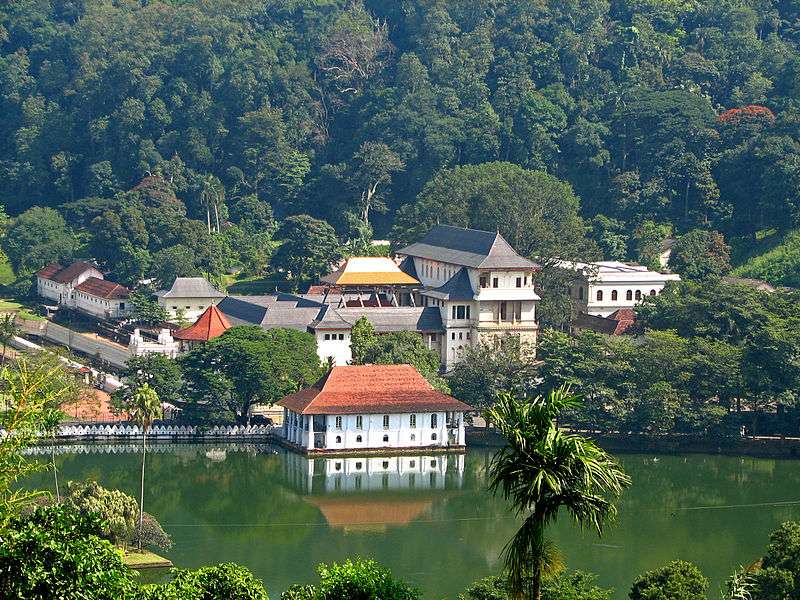Kandyan Convention
|
Kandyan Convention Signatories | |
| Drafted | 1815 |
|---|---|
| Signed | 2–18 March 1815 |
| Location | Temple of the Tooth, Kandy, Kingdom of Kandy |
| Condition | The deposition of King Sri Vikrama Rajasinha |
| Signatories | |
| Parties | 2 |
| Languages |
|
|
| |
Part of a series on the |
|---|
| History of Kandy |
 |
| Kingdom of Kandy (1469–1815) |
| Colonial Kandy (1815–1948) |
| Kandy (1948–present) |
| See also |
|
|
The Kandyan Convention was an agreement signed on the 10th of March 1815 between the British and the Chiefs of the Kandyan Kingdom, in Sri Lanka for the deposition of rule King Sri Vikrama Rajasinha. The king who was of South Indian ancestry faced powerful opposition from the Sinhalese chieftains who sought to reduce his power. A successful coup was organized by the Sinhala chieftains in which they accepted the British crown as their new king. This ended the line of the Kingdom of Kandy and King Rajasinha was taken as a prisoner. By 2 March 1815 the islands sovereignty was under that of the British Empire. This unique treaty was not signed by the deposed King but by members of his court and other dignitaries of the Kandyan Kingdom. Because the king was hiding from the British, later he was captured and banished to Vellore in south India. [1]
Before the signing of the convention, a British soldier took down the Kandyan flag and hoisted the Union Jack in its place. A Buddhist monk, Ven. Wariyapola Sri Sumangala Thero, saw what had happened and quickly replaced the British flag with the Kandyan one. The soldier got angry but before he could do anything, Sir John D'Oyly who was nearby, quickly defused the situation.
Signatories
British
- Robert Brownrigg - Quartermaster-General and in 1813 Governor of Ceylon
- John D'Oyly - Chief Translator to the Government
- Jas. Surtherland - Deputy Secretary to the Government
Kandyan
- Ehelepola Nilame
- Dullewe - Dissawa of Wellassa and Bintenna
- Ratwatte Nilame - Dissawa of Matale
- Galagoda Adikaram - Dissawa of Nuwara Kalawiya
- Molligoda - Maha Adigar & Dissawa of the Sath Korles
- Molligoda - Dissawa of Thun Korles
- Pilima Talawuwe - 2nd Adigar & Dissawa of Sabaragamuwa
- Pilima Talawuwe - Dissawa of Hathra Korles
- Monarawila - Dissawa of Uva
- Galagama - Dissawa of Tamankaduwa
- Galaboda Kankanama

Central Points of the agreement
The central pionts of the agreement were:
- 'Sri Wickrema Rajasinha', the 'Malabari' king, [is] to forfeit all claims to the throne of Kandy.
- The king is declared fallen and deposed and the hereditary claim of his dynasty, abolished and extinguished.
- All his male relatives are banished from the island.
- The dominion is vested in the sovereign of the British Empire, to be exercised through colonial governors, except in the case of the Adikarams, Disavas, Mohottalas, Korales, Vidanes and other subordinate officers reserving the rights, privileges and powers within their respective ranks.
- The religion of Buddhism is declared inviolable and its rights to be maintained and protected.
- All forms of physical torture and mutilations are abolished.
- The governor alone can sentence a person to death and all capital publishments to take place in the presence of accredited agents of the government.
- All civil and criminal justice over Kandyan to be administered according to the established norms and customs of the country, the government reserving to itself the rights of interposition when and where necessary.
- Other non-Kandyan's position [is] to remain [as privileged as previously] according to British law.
- The proclamation annexing the Three and Four Korales and Sabaragamuwa is repealed.
- The dues and revenues to be collected for the King of England as well as for the maintenance of internal establishments in the island.
- The Governor alone can facilitate trade and commerce.
See also
References
External links
- British Ceylon and Kingdom of Kandy 1805 (map)
- The Kandyan Convention and British policy
- 1815: Kandyan convention and the role of D’Oyly
- Short History of Ceylon By Humphrey William Codrington
- Sri Lankan Ethnic Crisis: Towards a Resolution By R. B. Herath
- The 1815 Kandyan Convention at the Audience Hall
- The signing of the Kandyan Convention
- Kandyan Convention of 1815
- Kandyan Convention of 1815 by Dr. K.D.G. Wimalaratne
